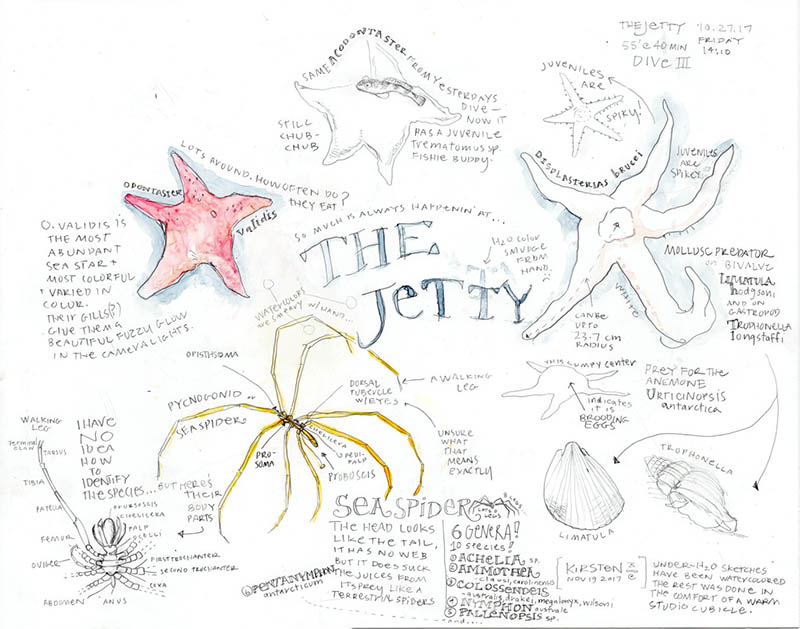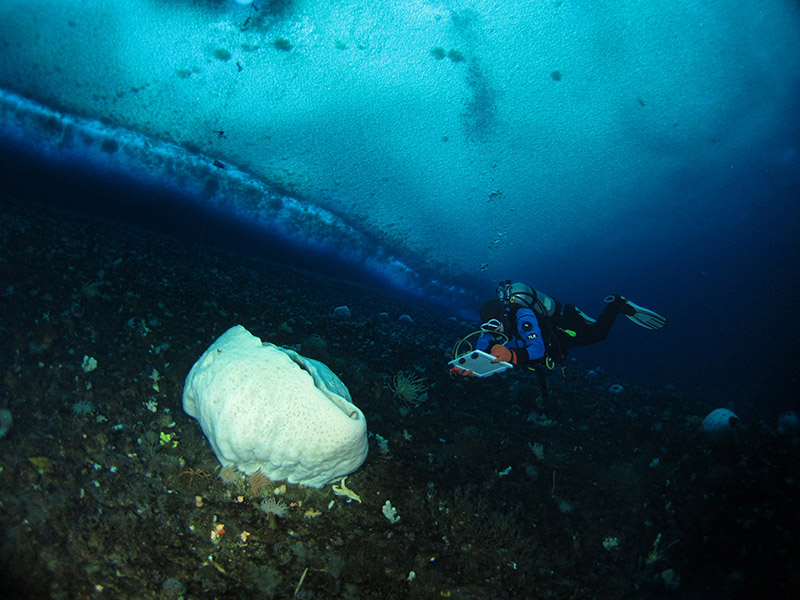Fathoming Life Under the IceArtists Dive Under Water to Explore the Antarctic EcosystemPosted July 17, 2018
This past austral summer season, two artists who specialize in science communication visited McMurdo Station to begin a multi-media, multi-faceted project with the aim of improving public knowledge of Antarctic marine life. 
Photo Credit: Kirsten Carlson
A giant Antarctic isopod (Glyptonotus antarcticus) trapped in ice becomes the subject for an encaustic painting created after a dive at the jetty.
Kirsten Carlson and Michelle Schwengel-Regala traveled to McMurdo Station from mid-October through early December to scuba dive under the frozen ocean surface to document the wide array of animals and organisms that live below. It is a time of year that is particularly spectacular, as visibility under the sea ice can extend 900 feet. Their trip to Antarctica was supported by the National Science Foundation, which manages the U.S. Antarctic Program. Over the course of their 33 dives, they took numerous photographs and videos and even sketched their surroundings in below-freezing water using waterproof supplies. Though the two have extensive diving experience, they encountered trials unique to cold water diving, which they tried to incorporate into their artistic process. “The challenges of drawing underwater were really interesting,” said Schwengel-Regala. “With any kind of fieldwork, you can expect a certain amount of variability in your process and products. Similarly, taking art-making out of a studio context often alters the end result. I found that once I donned all the cold-water dive gear and got underwater with the intense cold nipping at my extremities, any marks I made were so altered from what I could usually count on from my skill set.” Carlson added that in addition to the cold, the insulated scuba equipment itself presented its own challenge. “I knew the insulated gloves would challenge our ability to create detailed drawings. I have been underwater field sketching since 2006, but in warmer latitudes. In Antarctica, the thickness of the gloves limited us to creating blind contour drawings. But, we were able to evolve our methods with the help of the Antarctic dive program team of Rob Robbins, Steve Rupp and Brenda Konar,” Carlson said. Drawing on their years of Antarctic diving experience, Robbins and Rupp helped the artists adapt their drawing slates to the dark polar diving conditions. “They attached dive lights to our slates so we had a well-lit drawing area, and Steve added a video camera to my slate. The photographs and video are extremely helpful in augmenting drawings after the dive is over and we have hot cocoa in hand,” Carlson said. Though the work at McMurdo mainly consisted of illustration, photography, and writing, Schwengel-Regala also wanted to incorporate fiber into her work. “Rather than working in 2-D as I do with illustrations, I also create sculptures in fiber, often working at life size, with knitting techniques as my mode of action. By working in this manner I can create form and textures and spatial relationships to highlight the features and stories I want to tell,” Schwengel-Regala said. “The folks who explored Antarctica in the early twentieth century relied on wool and natural fibers for their survival. They did not have the technical and synthetic gear we have nowadays. I’m intrigued by the materials they used and I will continue to explore the role fiber plays in Antarctica.” In addition, she even tried knitting under water. “Before my last dive I prepared a project with really chunky acrylic yarn on big needles. I knit a number of rows on land, and the resultant stitches were regular and even. When I tried knitting it underwater, my stitch gauge was way off. I think I even dropped a few stitches,” Schwengel-Regala said. “During the few minutes spent on the project, these rows became a good example of the ability for humans to function in these contrasting conditions. Knitting may be a simple everyday activity which many can do so effortlessly up on land, but trying to accomplish the same task in this extreme environment was quite a challenge, demonstrating that we humans do not belong down there [under water].” 
Photo Credit: Kirsten Carlson
The underwater notes and sketches of artist Kirsten Carlson on waterproof paper made during a dive at the jetty.
Though the ecosystem under the ice is vibrant, because of the harsh environment, it is a realm where few members of the NSF’s Artist and Writers program have ventured. Most recently, Lily Simonson, a California-based artist collaborated with three field teams to create paintings focused on biodiversity in the McMurdo Dry Valleys and Ross Sea. She created a series of mural-size paintings based on organisms native to the Southern Ocean sea floor and the soil of the Dry Valleys. The paintings showcased uniquely adapted Antarctic invertebrates and their habitats. “It’s crazy to dive in subfreezing water through seven feet of ice,” Schwengel-Regala said with a laugh. “It takes a tremendous amount of nerve and patience to do this endeavor. By proposing that our project include diving, we added significant costs and complexity to our preparation, but direct access to this habitat was the best way to gather first-hand experience about this realm. Antarctica’s under-ice habitat still has so much left to be explored.” For their project, titled "Under the Ice: Two Artists Connect Audiences with Antarctic Sea Life and Science,” Carlson and Schwengel-Regala plan to produce an ongoing online journal where visitors can ask the artists questions, explore their dives and on-site adventures in Antarctica and see the latest updates for the collaboration. They also hope to produce a nonfiction children’s book and an exhibit incorporating their two and three-dimensional work. The multi-faceted project, they say, will allow both artists to share what inspires them with audiences around the globe. Schwengel-Regala and Carlson have both spent decades combining science with art. Schwengel-Regala began illustrating science as an undergraduate studying entomology and wildlife ecology, and worked as a professional science illustrator for 15 years. In addition, she also worked extensively in three-dimensional sculpture and fiber arts. Carlson received a Bachelor of Science with honors studying ornithology and field ecology. She dove in Antarctica for the first time in 1992 as a graduate student. After completing her education, she worked at Monterey Bay Aquarium for ten years as a graphic designer and freelances fulltime as a scientific illustrator, graphic designer, photographer and writer. Both artists are residents of Hawaii and graduates of the science-communication program at the University of California-Santa Cruz with a focus on natural science illustration. The program has subsequently relocated to California State Monterey Bay. The two met in 2016 through a UC Santa Cruz science illustration program listserv and discovered a mutual interest in marine science and art. They have been invited to participate in Schmidt Ocean Institute outreach programs together, but the Antarctic Artists and Writers program was the first project they embarked upon together as a team. "Antarctica is a canary in the coal mine. The polar seas will tell us what’s in store for the rest of the planet as our ecosystem strives for global equilibrium."
-Kirsten Carlson
Carlson, whose background also includes illustrating children’s books, enjoys telling stories and having the space to be creative, while Schwengel-Regala enjoys more technical aspects of science illustration. They hope that by producing several different projects they will reach a wider audience and allow people to form a connection between art, science and the natural world in different ways. Schwengel-Regala and Carlson hope the public will learn not just about Antarctic marine life, but also how Antarctica as a continent is so significant. “Antarctica is a canary in the coal mine. The polar seas will tell us what’s in store for the rest of the planet as our ecosystem strives for global equilibrium,” Carlson said. “We want to emotionally connect people to one of the most remote places on Earth through our artwork. We want the illustrations, videos and fiber replicas to capture peoples’ hearts and minds—to help them grasp that they can make a difference and help humanity thrive for generations to come.” Carlson also hopes the project will help others engage with science. “I’m on a quest to help people discover… that they have a little bit of scientist and artist in themselves. If I can give people access to what it’s like to ask ‘why?’ as a scientist might, or grasp how to draw something like an artist, that would mean a tremendous amount to me.” NSF-supported research in this article: Kirsten Carlson and Michelle Schwengel-Regala, Award No. 1645127. |



For USAP Participants |
For The Public |
For Researchers and EducatorsContact UsNational Science FoundationOffice of Polar Programs Geosciences Directorate 2415 Eisenhower Avenue, Suite W7100 Alexandria, VA 22314 Sign up for the NSF Office of Polar Programs newsletter and events. Feedback Form |


